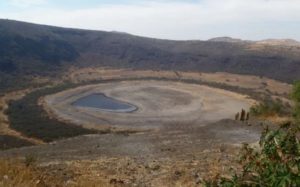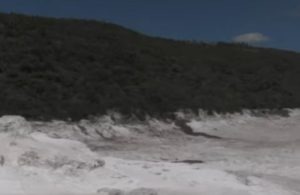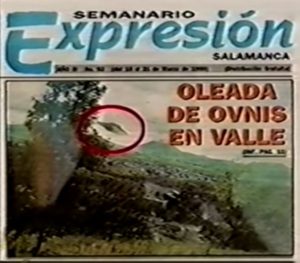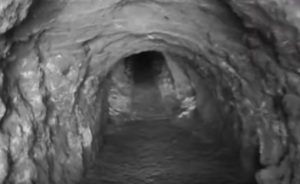Podcast: Play in new window | Download
Subscribe: Apple Podcasts | RSS
 The south-central part of the State of Guanajuato near the township of Valle de Santiago is a wonderland for alternative researchers. It is home to what the locals call the Siete Luminarias, or in English, “The Seven Luminaries,” which are 7 old volcanic craters. The natural wonders of the region aside, the area in and around these luminarias contains everything a curious person could ask for: UFOs, strange creatures, ghosts, bizarre biology, mysterious cures, interdimensional vortexes, legends of giants and traces of lost civilizations. Many of the craters either had water up until recent times or currently have water inside them, and all draw tourists, recreation seekers and those interested in the paranormal. Although part of an old volcanic field of many craters spread across a wide area, these 7 craters are the largest and most distinct. Their names, in no particular order are: La Alberca, La Hoya de Cintora, La Hoya de Álvarez, La Hoya de San Nicolás de Parangono, La Hoya Blanca, La Hoya de Solís and El Rincón de Parangueo. All craters are under the protection and administration of the municipality of Valle de Santiago which has seen explosive population growth in recent years and this has impacted the volcanoes tremendously. The craters still, however, have managed to retain most of their mystery despite the recent changes.
The south-central part of the State of Guanajuato near the township of Valle de Santiago is a wonderland for alternative researchers. It is home to what the locals call the Siete Luminarias, or in English, “The Seven Luminaries,” which are 7 old volcanic craters. The natural wonders of the region aside, the area in and around these luminarias contains everything a curious person could ask for: UFOs, strange creatures, ghosts, bizarre biology, mysterious cures, interdimensional vortexes, legends of giants and traces of lost civilizations. Many of the craters either had water up until recent times or currently have water inside them, and all draw tourists, recreation seekers and those interested in the paranormal. Although part of an old volcanic field of many craters spread across a wide area, these 7 craters are the largest and most distinct. Their names, in no particular order are: La Alberca, La Hoya de Cintora, La Hoya de Álvarez, La Hoya de San Nicolás de Parangono, La Hoya Blanca, La Hoya de Solís and El Rincón de Parangueo. All craters are under the protection and administration of the municipality of Valle de Santiago which has seen explosive population growth in recent years and this has impacted the volcanoes tremendously. The craters still, however, have managed to retain most of their mystery despite the recent changes.
The Spanish first started settling the area in the early 1600s, formally establishing the town of Valle de Santiago in May of 1607. The local Tarascans or Purépecha people called the area of small volcanic cones Camémbaro, which roughly translates to “Place of Wormwood.” In pre-Hispanic times these seven volcanoes were said to have once been young women who were all after the affections of a handsome prince. Although the women were beautiful, their competition for the prince’s attention caused the young royal great upset. The prince wanted to be left alone and asked a powerful sorcerer to deal with the situation. The sorcerer used his dark magic to transform the women into these 7 craters. The layout of the craters curiously forms the shape of the constellation Ursa Major, or the Big Dipper. Some locals believe that when Ursa Major is lowest, between the 18th of April and the 18th of May, the craters absorb the most energy from the heavens and thus become “recharged.” Those who tend to believe that the craters experience a recharging every spring also believe that the Valle de Santiago area is the magnetic center of the earth. The heightened magnetism in the area is responsible for the many strange things existing in the region, which might take a full-length book to explore adequately.
 One of the most curious of the craters is called La Alberca. This translates from Spanish to English as, “The Swimming Pool.” For many years this crater attracted recreational bathers who approached swimming in the crater’s lake with caution. From early on people believed the lake to be bottomless. With the idea of a bottomless lake came other related stories. What strange creatures could lurk in those unknown depths? Locals claimed that an aquatic reptile much like Scotland’s Loch Ness Monster lived in the lake and sometime in the early 1970s a blurry photograph of a dinosaur-looking creature made its rounds through the press. People gave the creature a name: Chac. Some believe that the photo and accompanying stories were concocted just to bring tourists to the area. The lake monster, apparently, was not confined to the small area inside the crater. La Alberca supposedly had subterranean connections to both the Atlantic and Pacific Oceans, so the monster could make its way out to the open sea if it wished. Some also have claimed that the waters of La Aberca are home to the tlanchana, a half-female, half-serpent-like creature that approximates a mermaid and dates back hundreds if not thousands of years. For more information on the tlanchana, please see Mexico Unexplained episode number 47: https://mexicounexplained.com//la-tlanchana-mexican-mermaid-legends/ In the late 1970s, Mexico’s First Lady, Carmen Romano de López Portillo would go night swimming in the lake accompanied by Israeli psychic and magician Uri Geller to take advantage of the lake’s magical curative properties. All the water-based myths and legends about La Alberca seem to have dried up with the lake. In the early 2000s the lake’s water level dropped dramatically due to human depletion of the local aquifer. As the population of Valle de Santiago exploded and water demands increased at an astronomical pace, the water in the “bottomless lake,” disappeared. Now, the center of the crater has reverted to a desert environment full of scrubby trees and cactus. When heavy rains come, occasionally pools form, but never last. It is quite ironic that the crater named “The Swimming Pool” is now devoid of water. The lack of water laid bare the bottom of the lake thus destroying notions of La Alberca having connections to the ocean. There was no escape route for a swimming dinosaur named Chac and no more space for legendary mermaid creatures to frolic in. Most of the legends surrounding this specific crater just simply evaporated.
One of the most curious of the craters is called La Alberca. This translates from Spanish to English as, “The Swimming Pool.” For many years this crater attracted recreational bathers who approached swimming in the crater’s lake with caution. From early on people believed the lake to be bottomless. With the idea of a bottomless lake came other related stories. What strange creatures could lurk in those unknown depths? Locals claimed that an aquatic reptile much like Scotland’s Loch Ness Monster lived in the lake and sometime in the early 1970s a blurry photograph of a dinosaur-looking creature made its rounds through the press. People gave the creature a name: Chac. Some believe that the photo and accompanying stories were concocted just to bring tourists to the area. The lake monster, apparently, was not confined to the small area inside the crater. La Alberca supposedly had subterranean connections to both the Atlantic and Pacific Oceans, so the monster could make its way out to the open sea if it wished. Some also have claimed that the waters of La Aberca are home to the tlanchana, a half-female, half-serpent-like creature that approximates a mermaid and dates back hundreds if not thousands of years. For more information on the tlanchana, please see Mexico Unexplained episode number 47: https://mexicounexplained.com//la-tlanchana-mexican-mermaid-legends/ In the late 1970s, Mexico’s First Lady, Carmen Romano de López Portillo would go night swimming in the lake accompanied by Israeli psychic and magician Uri Geller to take advantage of the lake’s magical curative properties. All the water-based myths and legends about La Alberca seem to have dried up with the lake. In the early 2000s the lake’s water level dropped dramatically due to human depletion of the local aquifer. As the population of Valle de Santiago exploded and water demands increased at an astronomical pace, the water in the “bottomless lake,” disappeared. Now, the center of the crater has reverted to a desert environment full of scrubby trees and cactus. When heavy rains come, occasionally pools form, but never last. It is quite ironic that the crater named “The Swimming Pool” is now devoid of water. The lack of water laid bare the bottom of the lake thus destroying notions of La Alberca having connections to the ocean. There was no escape route for a swimming dinosaur named Chac and no more space for legendary mermaid creatures to frolic in. Most of the legends surrounding this specific crater just simply evaporated.
A land-based legend still survives around La Alberca and some of the adjacent craters. Many hikers have reported seeing an indigenous woman, or an apparition of an indigenous woman, wearing traditional clothing and carrying a load on her back. The woman appears confused and distressed, as if lost, and comes up to people eager to chat, but no one can understand her language. When people run away in fright, the woman tends to cry or yell desperately after them. Some get the impression that this ghostly native woman just wants other human company or has somehow found herself trapped in modern times after passing through some sort of vortex. As the Valle de Santiago is supposedly a high energy area, some eyewitnesses have reported seeing portals or vortexes opening up right before their eyes. One legend has it that the indigenous woman was a slave working for the Spanish in colonial times and killed herself by drowning herself in the waters of La Alberca. As with many myths and legends, this one seems to have several different versions.
 The municipality of Valle de Santiago maintains a small museum and tourist office devoted to the craters near the center of town. There, one can hire a guide to explore the volcanoes who is more than willing to share with the tourist the local history and lore. Inside the museum a sign proclaims that the area has a nickname: “Ovnilandia.” This translates into English as, “UFO Land.” Indeed, the region boasts many sightings of unidentified flying objects. In the late 1990s Mexico-City-based TV Azteca sent a film crew to Valle de Santiago to cover the UFO topic and to delve into some of the stranger mysteries of this part of the State of Guanajuato. While filming, the TV Azteca crew caught a flying-saucer-shaped UFO skirting around the far side of the bell towers of the town’s church. Millions of Mexicans later saw this footage on the TV Azteca network and after the program aired the town attracted UFO researchers from around the world. For decades many locals have claimed to see UFOs flying into the volcanoes and disappearing into the lakes. This leads to a whole host of other stories and speculations. There are UFO bases inside the earth, is a popular story. This ties into another legend that a race of giants lives in a system of gigantic caverns and tunnels in and around the craters, and this race is either controlling or being assisted by the UFOs. The largest cave system allegedly exists under Rincón de Parangueo, which is considered to be the most “energetically active” of all the craters. There are several “Middle Earth” or “Hollow Earth” stories from various parts of Mexico. Many of these stories date back to a time well before the Spanish arrived and are connected to volcanoes. For more information about this general idea of volcanoes as entranceways to other worlds, please see Mexico Unexplained episode number 84 titled, “Mexican Volcanoes, UFOs and Strange Humanoids” https://mexicounexplained.com//mexican-volcanoes-ufos-strange-humanoids/
The municipality of Valle de Santiago maintains a small museum and tourist office devoted to the craters near the center of town. There, one can hire a guide to explore the volcanoes who is more than willing to share with the tourist the local history and lore. Inside the museum a sign proclaims that the area has a nickname: “Ovnilandia.” This translates into English as, “UFO Land.” Indeed, the region boasts many sightings of unidentified flying objects. In the late 1990s Mexico-City-based TV Azteca sent a film crew to Valle de Santiago to cover the UFO topic and to delve into some of the stranger mysteries of this part of the State of Guanajuato. While filming, the TV Azteca crew caught a flying-saucer-shaped UFO skirting around the far side of the bell towers of the town’s church. Millions of Mexicans later saw this footage on the TV Azteca network and after the program aired the town attracted UFO researchers from around the world. For decades many locals have claimed to see UFOs flying into the volcanoes and disappearing into the lakes. This leads to a whole host of other stories and speculations. There are UFO bases inside the earth, is a popular story. This ties into another legend that a race of giants lives in a system of gigantic caverns and tunnels in and around the craters, and this race is either controlling or being assisted by the UFOs. The largest cave system allegedly exists under Rincón de Parangueo, which is considered to be the most “energetically active” of all the craters. There are several “Middle Earth” or “Hollow Earth” stories from various parts of Mexico. Many of these stories date back to a time well before the Spanish arrived and are connected to volcanoes. For more information about this general idea of volcanoes as entranceways to other worlds, please see Mexico Unexplained episode number 84 titled, “Mexican Volcanoes, UFOs and Strange Humanoids” https://mexicounexplained.com//mexican-volcanoes-ufos-strange-humanoids/
Some local residents and visitors have claimed actual extraterrestrial contact in the area around the volcanoes. The most popular beings sighted in connection with the UFO phenomenon are the Nordics and the Greys. The Nordics are tall blond humanoids who are friendly and helpful in UFO lore. The Greys are the short, big-headed and big-eyed creatures with spindly limbs who carry out nefarious experiments on unsuspecting abductees. Longtime Valle de Santiago resident Oscar Arredondo Ramírez claims to have had several contacts with extraterrestrials who have imparted to him several secrets, some of which could save humanity. Señor Arredondo states that his first extraterrestrial visitation took place around 1970. It was then when the aliens shared with him a way to end world hunger. Coincidence or not, during the 1970s farmers in the areas closest to the volcanoes began raising gigantic fruits and vegetables. Onions the size of basketballs. Beets the size of shoe boxes. Heads of lettuce one meter tall. A 6-foot-long leaf of swiss chard could feed a whole family for a week. When photos of these enormous fruits and vegetables reached the  outside world, many dismissed the pictures as having been altered using simple camera tricks or after-the-fact cut-and-paste techniques. Eventually, the huge produce caught the attention of SAGARPA, the Secretariat of Agriculture and Rural Development, a bloated federal government agency based in Mexico City. Investigators and inspectors from the agency wanted to visit the Valle de Santiago to talk to the farmers, but the farmers balked and said they would not speak to government officials about their growing secrets unless some demands were met. The farmers wanted a new school and they also wanted the national government to take over management of the craters, to turn them into national preserves so as to attract more tourism to the area. When the farmers made these demands, the agricultural ministry immediately dismissed the whole thing as a hoax and did not send anyone to investigate. The gigantic fruits and vegetables continued to garner attention and one university group concluded that the reason why some of these plants grew so much larger than normal had to do with the density and complexity of the minerals in the area’s soils. Oscar Arredondo Ramírez and the farmers refused to give up their secrets and the lands around the volcanoes continue to produce about fifteen times the average yield per acre over any other place in Mexico. In an interview from the year 2013, Arredondo did tell a reporter that the farmers had a secret method of harnessing the area’s energies as told to them by the extraterrestrials, but he declined to give further details as to exactly how.
outside world, many dismissed the pictures as having been altered using simple camera tricks or after-the-fact cut-and-paste techniques. Eventually, the huge produce caught the attention of SAGARPA, the Secretariat of Agriculture and Rural Development, a bloated federal government agency based in Mexico City. Investigators and inspectors from the agency wanted to visit the Valle de Santiago to talk to the farmers, but the farmers balked and said they would not speak to government officials about their growing secrets unless some demands were met. The farmers wanted a new school and they also wanted the national government to take over management of the craters, to turn them into national preserves so as to attract more tourism to the area. When the farmers made these demands, the agricultural ministry immediately dismissed the whole thing as a hoax and did not send anyone to investigate. The gigantic fruits and vegetables continued to garner attention and one university group concluded that the reason why some of these plants grew so much larger than normal had to do with the density and complexity of the minerals in the area’s soils. Oscar Arredondo Ramírez and the farmers refused to give up their secrets and the lands around the volcanoes continue to produce about fifteen times the average yield per acre over any other place in Mexico. In an interview from the year 2013, Arredondo did tell a reporter that the farmers had a secret method of harnessing the area’s energies as told to them by the extraterrestrials, but he declined to give further details as to exactly how.
 Besides the Mexican first lady and Uri Geller, since pre-Hispanic times people have visited the waters of the Siete Luminarias for their curative or magical properties. The Hoya de Cintora and the Hoya de Álvarez both have areas set aside for bathers and those who seek relief from various ailments. These two craters also have caves above the waterline that have inside them murals and glyphs that date back hundreds if not thousands of years. Locals attribute the drawings to the Maya, but archaeologists disagree; the Maya heartland is hundreds of miles to the east and there was little or no contact between the two regions in ancient times. Although not considered Maya, researchers are at a loss to attribute any other culture as responsible for the cave art. The waters have not only been used in cures but have also been used in divination. For centuries people have noticed that the waters within certain craters turn different colors. Some colors forewarn of disasters or other bad things to come. All the waters in the lakes turned red in the days before the 1985 Mexico City earthquake, for example. There are a few specialists in the area who can interpret these changes in color.
Besides the Mexican first lady and Uri Geller, since pre-Hispanic times people have visited the waters of the Siete Luminarias for their curative or magical properties. The Hoya de Cintora and the Hoya de Álvarez both have areas set aside for bathers and those who seek relief from various ailments. These two craters also have caves above the waterline that have inside them murals and glyphs that date back hundreds if not thousands of years. Locals attribute the drawings to the Maya, but archaeologists disagree; the Maya heartland is hundreds of miles to the east and there was little or no contact between the two regions in ancient times. Although not considered Maya, researchers are at a loss to attribute any other culture as responsible for the cave art. The waters have not only been used in cures but have also been used in divination. For centuries people have noticed that the waters within certain craters turn different colors. Some colors forewarn of disasters or other bad things to come. All the waters in the lakes turned red in the days before the 1985 Mexico City earthquake, for example. There are a few specialists in the area who can interpret these changes in color.
In an often-overlooked corner of the Mexican State of Guanajuato several dead volcanoes invoke wonder among tourists and locals alike. The area around the Siete Luminarias remains one of the most mysterious regions in all of Mexico.
REFERENCES:
The official web site (in Spanish) of the municipality of Valle de Santiago: http://valledesantiago.org.mx/volcanes_de_valle_de_santiago.html
recondito.org web site (in Spanish)
